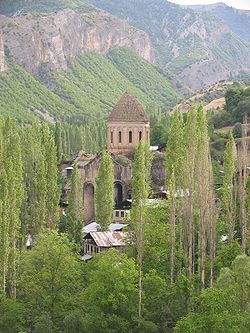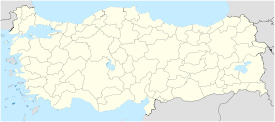- Oshki
-
Oshki 
Oshki (963-973), church of St John the Baptist, from the east
Basic information Location Çamlıyamaç, Uzundere district, Erzurum Province,  Turkey
TurkeyGeographic coordinates 40°36′49″N 41°32′32″E / 40.613712°N 41.542111°ECoordinates: 40°36′49″N 41°32′32″E / 40.613712°N 41.542111°E Affiliation Georgian Orthodox Church[citation needed] Architectural description Groundbreaking 963 Completed 973 Oshki (Georgian: ოშკი) is a Georgian[1][2][3][4][5][6][7][8][9] monastery from the second half of the 10th century located in the historic province of Tao, now in North-eastern Turkey. The main church, dedicated to St John the Baptist, was built between 963 and 973.
Oshki monastery was a major centre of Georgian literature and enlightenment during the Middle Ages.[10]
Contents
Architectural sculpture and figurative reliefs
The construction of the monastery at Osk/Oshki was sponsored by the Georgian Kings Bagrat eristavt-eristavi (prince of princes) and David III Bagrationi Kuropalates.
The blind arches are an important part of the whole decoration. In Oshki they stretch along the outer walls of the church in the south, east and north. It is an early example of the use of decorative blind arches on the facades. They divide the wall in line with the general architectural rhythm. The central part of the facade is mainly decorated with bas-reliefs.
Bas-reliefs, placed high above the central arch, are given the place of honour on the southern facade, which is the main facade of the church. They stand out from the flat surface. The eagle with an animal in his talons probably symbolises victory, and the whole sculptural composition the triumph of the heavenly forces represented by the archangels Michael and Gabriel.
In the province of Tao the power lay in the hands of the ruling dynasty of the Bagrationi, whose members Bagrat eristavt-eristavi and David Magistros are depicted lower down on the same facade, near the deesis, to show that the heavenly forces were the family's patrons.
The figures are well proportioned, elegant in contour and form. The static postures of earlier donor portraits give way to free movement, and an equal attempt can be traced in the near three-dimensional renderings of the archangels and the deesis of the southern facade, as well as on a column in the southern gallery. The decorative system of the Oshki church also includes the low reliefs characteristic of the so-called transitional period in medieval Georgian art (8th - 10th centuries), when the old style had not yet given way completely, and new ways were evolving. Sculptors of the different generations must have worked on it. The church in Oshki already shows the tendencies that would eventually develop in the 11th century.
Inscriptions
Inscription №1
Inscription in Georgian language, telling who were builders of Oshki.
The first inscription in Oshki temple is drawn with Sanguri (Georgian: სანგური) color and is located over the southern main entrance to the temple. Nowadays 12 lines still exist. All inscriptions are written with Mrgvlovani, the earliest version of Georgian script. The original can be seen on the illustration in the right. The first scientist who explored this inscription was Marie-Félicité Brosset, a French orientalist who specialized in Georgian and Armenian studies.[11] Later these inscriptions were researched by Ekvtime Takaishvili and Wachtang Djobadze. As noted by Wachtang Djobadze, the first inscription gives a lot of information about the temple. It mentions the names of Ktetors of the church - Georgian kings Bagrat Eristavt-Eristavi and David III Kuropalates. Also there is information about architect of the church - someone called Grigol.[12]
- მოწყალებითა ღ(მრ)თისაჲთა რ(ომე)ლი სცავს ყ(ოვე)ლთა მოშ(ი)შთა მ(ი)სთა და წარმოჳმართ(ე)ბს მოყოჳარეთა სახელისა მისისათა ყ(ოვე)ლთა ს(ა)ქმ(ე)
- თა კ(ე)თ(ი)ლთა ამის წ(მი)დისა ს(ა)მ(ე)ბ(ი)სა სარწმოჳნოვებ(ი)თა და მ(ეო)ხ(ე)ბ(ი)თა წ(მი)დისა დ(ე)დოფლისა ჩ(უე)ნისა ღ(მრ)თ(ი)სმშობ(ე)ლისაჲთა მ(ა)დლითა წ(მი)დ(ა)ჲსა ძ(ე)ლისაცხოვრებისაჲ
- თა შეწ(ე)ვნითა და მეოხ(ე)ბ(ი)თა დიდებოჳლისა ნათლი[ს]მცემლისაჲთა და ყ(ოვე)ლთა წმიდაჲთაჲთა რ(ომელ)ნი საოჳკოჳნითგ(ა)ნ სათნო ეყ(უ)ნ(ე)ს ღ(მერ)თსა ამათ ყ(ოვე)ლთა
- წმიდათა სადიდებ(ე)ლ(ა)დ და საქებ(ე)ლ(ა) იწყ(ე)ს ღ(მრ)თივ გოჳრგოჳნოს(ა)ნთა მ(ე)ფ(თ)ა ჩ(უე)ნთა შ(ე)ნ(ე)ბ(ა)დ ამის წმიდისა ს(ა)ყდრისა რ(ა)თა ამას შ(ი)ნა აღესროჳლებოდიან დღესა
- სწაოჳლნი და შეიმკვებოდიან ჴსენებ(ა)ნი წმიდათანი ვ(ითარც)ა წერილ არს ჴსენებასაწმიდათასა ეზიარებოდ(ე)თ ამათ ყ(ოვე)ლთა წმიდათა სოჳრვილითა
- ამათ დიდეოჳ[ლ]თა მ(ე)ფ(ე)თა ჩ(უე)ნთა ოჳშოჳრვ(ე)ლ ყ(უ)ნენ საფას(ე)ნი წარმავ(ა)ლნი წარ[ო]ჳვალისა მ(ი)სთოჳის რ(ა)თა ყ(ოველ)ნი წმიდანი შემწ(ე)დ მოიგნენ და ღმერთმან შ(ეე)წ(იე)ნ ორთავე
- ცხოვრებ(ა)თა ძ(ე)თა ღ(მრ)თ(ი)ვ კოჳრთხეოჳლისა ადარნასე კოჳრაპალატისატა ბ(ა)გრ(ა)ტ ერისთავთა ერისთ(ა)ვმ(ა)ნ დავით მაგისტროსმ(ა)ნ სამებამ(ა)ნ წმიდამან
- სამნივე დაიფარენ მორჯოჳენითა თ(ჳ)სითა და ა(დი)დ(ე)ნ ორთავე ცხორებ(ა)თა და მე გრიგოლ ღირს მყო ღ(მრერთმა)ნ მსახოჳრებ(ა)სა ამას მ(ა)თსა ღ(მრ)თისა მიმართ და მე ვიყ
- ავ სა[ქ]მესა ზ(ედ)ა-მ[დ]გომი და არწმოჳნა ღ(მერთმა)ნ გონებასა მ(ა)თსა ერთ-გოჳლობაჲ ჩ(ე)მი მ(ო)ნისა მ(ა)თისაჲ ესე იყო გალატოზთა და მოქმედთა მიზდი და აზავერთა მექოჳიშე
- თაჲ რ(ომე)ელ წელიწადსა წარეგების დრამაჲ :კ: ათასი ღოჳინოჲ ფ(ისო)სი :ჭ: რკინაჲ ლიტრი :ნ: ხოჳარბალი გრივი :ს:მ:ი: გალატოზი და ხო[ჳ]როჲ და მჭედელი რ(ომე)[ლმა]რადის შ(უ)რებო
- და ჲ:ი: ჴ(ა)რი რ(ომ)ელ ქვასა კრ(ე)ბდა :ლ: ჯორი და სხ(უ)აჲ აზავერი რ(ომე)ლ გრიგოჳლ-წმიდით სპონდიკსა კრ(ე)ბდა :ლ: სხოჳაჲ აზავერი რ(ომე)ლ [-] [კრ(ე)]ბდა :ჲ: [-]
- ჲდა [-] [ყი]ერი და მოქმედი :პ:[11]
Gallery
References
- ^ ОШКИ — грузинский средневековый монастырь (на территории Турции). Грандиозный собор (окончен между 958 и 961) с рельефным декором и росписью (1036). … (Modern Encyclopaedia)
- ^ ОШКИ — - грузинский средневековый монастырь (ныне на территории Турции), один из культурных центров Грузии. Грандиозный собор (окончен между 958 и 961); трехапсидное купольное здание, украшенное аркатурой, резными наличниками, рельефными… (Big Encyclopaedic Dictionary)
- ^ Ошки — грузинский средневековый монастырь (ныне на северо востоке Турции); один из культурных центров феодальной Грузии. Грандиозный собор (окончен между 958 и 961, архитектор Григол): в плане триконх с капеллами по сторонам каждой конхи;… (Encyclopaedia of art)
- ^ Ошки — грузинский средневековый монастырь (ныне на северо востоке Турции), один из духовно религиозных и культурных центров Грузии. Грандиозный собор (окончен между 958 и 961) трёхапсидное купольное здание, украшенное аркатурой, резными… (Encyclopaedic Dictionary)
- ^ The real and ideal Jerusalem in Jewish, Christian, and Islamic art: studies in honor of Bezalel Narkiss on the occasion of his seventieth birthday; Bianca Kühnel, Bezalel Narkiss
- ^ American Encyclopaedia
- ^ Art and identity in thirteenth-century Byzantium: Hagia Sophia and the empire of Trebizond Antony Eastmond
- ^ Bread and ashes:a walk through the mount ains of Georgia Tony Anderson
- ^ OSHKI, World Monument Fund
- ^ Levan Menabde, Centres of ancient Georgian culture, 1968.
- ^ a b M. Brosset, Inscriptions géorgiennes et autres recueillies par le P. Nerses Sargisian, Mékhitariste de S.Lazare, et expliquées par M.Brosset; Mémoires de l'Académie impériale des sciences de St.Pétersbourg, VII ser., t. VIII, no.10 (S.-Petersbourg, 1864), стр.1-24
- ^ Wachtang Djobadze - Georgian monasteries of early medieval period in historical Tao, Klarjeti and Shavsheti = ადრეული შუა საუკუნეების ქართული მონასტრები ისტორიულ ტაოში, კლარჯეთსა და შავშეთში / Editor - M.Lordkipanidze. — Tb.:Universal, 2007. — 346 p. — ISBN 978-99940-61-11-2
External links
- Virtualtao-klarjeti.com - Oshki, Oshki scriptorium and refectory;
- Leila Khuskivadze, Georgian-Byzantine relations on the example of tao-Klarjeti relief sculptures, In Proceedings of the 21st International Congress of Byzantine StudiesProceedings of the 21st International Congress of Byzantine Studies, International Congress of Byzantine Studies, London, 21–26 August 2006, P. 300-301, ISBN 10075465740X., Google Books
Categories:- Georgian churches in Turkey
- 970s architecture
- Christian monasteries established in the 10th century
Wikimedia Foundation. 2010.





